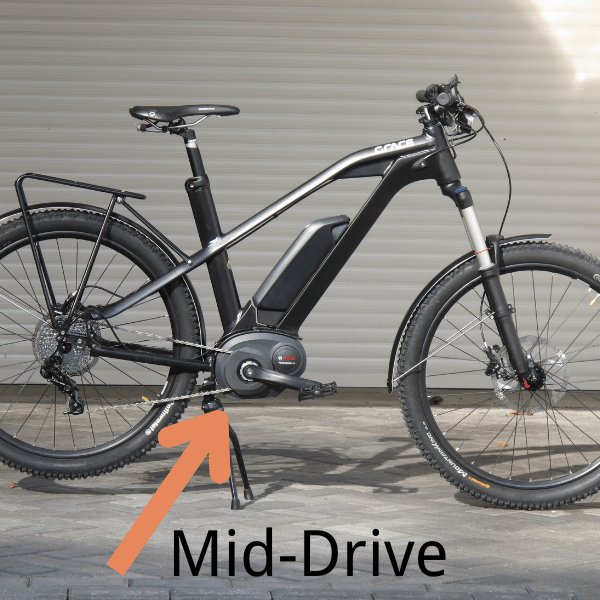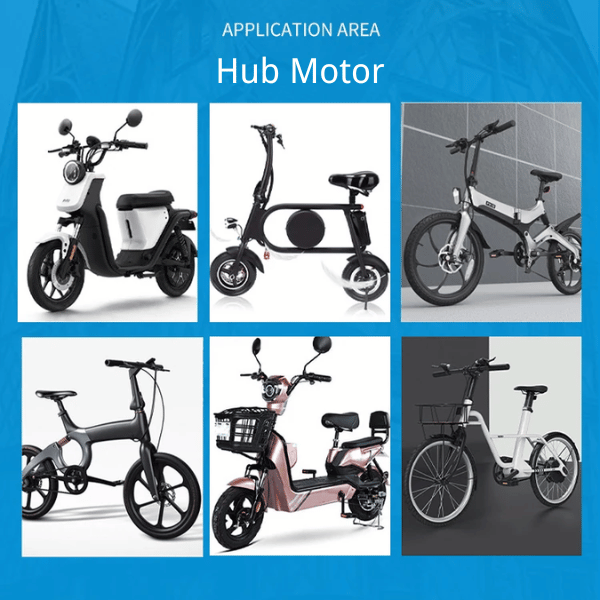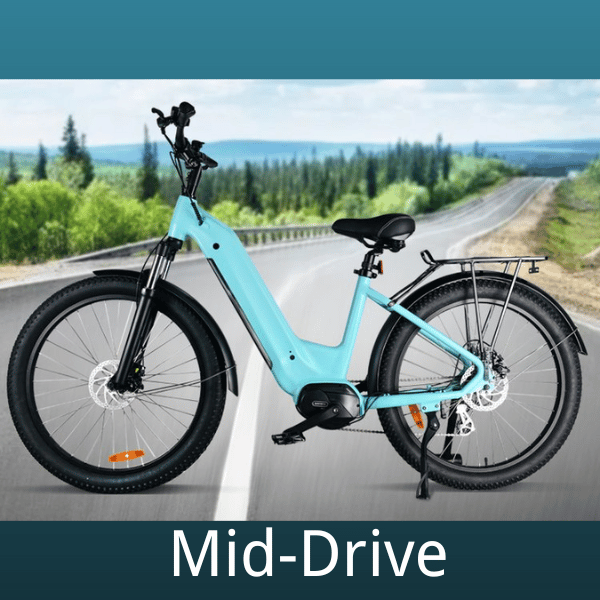Comparing Hub Motor vs Mid-Drive: Choosing the Best Electric Bike Motor
The decision between a hub motor and a mid-drive motor can make a huge difference in electric bikes. Picking the perfect engine type for an e-bike requires comprehending their fundamental features. In this study, we will examine in detail the technical specifications, performance differences, and practical uses of both kinds of motors: Hub Motors and Mid-Drive motors. We have tried to equip you with adequate knowledge on some unique properties of these two types that will help you decide which is more suitable for your E-bike riding.
What are the main disparities between hub motors and mid-drive electric bike motors?
The location, efficiency, and performance are among several key distinctions between hub motors and mid-drive motors used in electronic bikes. These leading models differ because the first set is placed inside wheels instead of being installed near pedals like in the other competitor’s examples. The best environments for using this system are flat terrains with little maintenance because the system has a simple design. Hub motors perform well on light gradients, during urban commuting, or on long flat stretches with no elevations, but on steep inclines, they may underperform since they do not have enough torque compared to mid-drives.
Hub Motor Characteristics
Acceleration and top speed are affected by whether a hub motor is direct drive or geared. Hub motors have been designed to be easily installed within wheel hubs without requiring maintenance which makes them cheaper alternatives. They work properly on flat surfaces hence preferable for urban cycling while on hill areas where there is low torque compared to middle drives then they might fail to perform very well.

Mid-drive Motor Features
Mid-drive motors enhance a bike’s performance through the use of gears, thereby increasing efficiency in its operations, especially when climbing hills among other difficult terrains. These engines are positioned centrally, thereby offering better weight distribution as well as contributing towards better balance, hence enhancing rider control over them. This kind is more preferred in mountain biking and when it comes to hilly commutes as they have higher torque and smoother gear changes.

Hub-driven motors benefits and drawbacks
Hub motors gives electric bike fans a unique mix of simplicity and efficiency. The following section suggests the pros and cons of selecting a hub drive system for your cycling experience, followed by a brief comparison to guide you in your choice.

Advantages of hub drive
Mid-drives have more moving parts, so they are more maintenance-demanding than hub drives. The hub placement results in a simple design that cuts down on mechanical breakdowns. They also use less expensive materials, which makes them affordable even for low-income riders. Their simplicity makes them ideal for slow rides around city streets or flat terrains.
Disadvantages of hub drive
However, these are not the best options when it comes to steep climbs or rough terrain where power output requirements are very high. Positioning the motor affects how much energy is used up while riding the bike since it affects its balance and weight distribution making it less efficient. Such problems could be problematic especially for those riders who usually go through different terrains or want their cycling activities to be dynamic. Hence, there are fixed gear ratios for these motors which limit range throughout variance in cycling conditions to maintain speed and maximize efficiency.
Mid-drive motor advantages on electric bikes
Mid-drive motors improve the performance and efficiency of electric bikes by optimizing power distribution and improving climbing capabilities. They are a versatile solution for today’s cyclists, well-suited to leisurely rides within cities and rugged terrains.

Increased torque with mid-drives
Mid-drive motor technology outperforms hub-driven counterparts in terms of torque, which helps it climb better and accelerate faster. They use the bicycle’s gears to draw out the best efficiency over different surfaces. This means that riders can keep up speed or have a smoother ride at steep inclines without stressing the motor.
Better weight distribution with mid-drive systems
On electric bikes, mid-drive motors help in achieving a better-balanced weight distribution. These systems position their motors centrally and closer to the ground resulting in low centers of gravity. This desirable mass placement increases bicycle stability while promoting ease of handling. Additionally, it also aids the rider in controlling the bike thus providing a more natural feel on rough roads and making cycling more comfortable overall
Which one is better for hilly terrains; mid-drive or hub motor?
The choice between hub motors and mid-drive systems is very significant when one is looking for the best motor to tackle hilly terrains on an electric bike. This section aims at examining which of these alternatives is more suitable for inclines in terms of torque and efficiency.
Performance Comparison on Steep Hills
Mid drive motors perform better than hub motors on steep hills because they can use the bicycle’s gear system. This makes them have efficient power usage and good climbing ability. Mid-drives have improved torque, and they maintain higher uphill speed without causing strain to the motor. On the other hand, hub motors are only good for flat surfaces or slight slopes but are not effective on steeper grounds due to their fixed gear ratio resulting in an inefficient performance.
Torque Application on Hilly Terrains
In case of hilly terrains, torque that refers to the rotational force produced by a motor becomes a determinant of its performance. Mid-drive motors have higher torques since they use gears ratios of bicycles that may give more climbing ability with no extra energy consumption. This is especially useful when going uphill where maintaining momentum is important. The geared mechanism found in mid-drive helps distribute torque flexibly thereby enhancing maximum performance and efficiency along different gradients.
Things to Consider When Choosing Between a Hub Drive and Mid-drive Electric Bike Motor
The choice of the appropriate electric bike engine depends on the particular riding needs, including terrain, performance expectations, and maintenance capabilities. This section will outline important factors to consider in order to make an informed decision that improves your cycling experience.
Understanding what the rider prefers
Each rider has different requirements that are affected by typical riding terrains, desired speed, and level of physical effort they want to exert. Mid-drive motors may be better suited for riders who often cycle through hilly regions because they have more torque and can climb hills better than other types of motors. It might be more attractive for those mostly biking on flatlands due to its simplicity and low cost as a hub motor. Moreover, this decision also affects how the entire bike weighs and handles, factors necessary for one’s comfortable and safe ride.
Maintenance comparison between both motor types
Maintenance is an essential factor that is sometimes forgotten when making decisions. Compared with hub motors mid-drive motors require more attention to them owing to their higher complexity in relation with drive train of a bicycle especially when frequently used over challenging terrains. There could be high wear on chains and gears since these systems are complex. Conversely, hub motors provide a much simpler compact system generally resulting into lower maintenance requirements and ease of repair procedures. It is vital for such riders choosing their electric bicycles to take note of such differences in respect to maintenance requirements as well as costs associated with them.
How does the choice between hub motor and mid-drive affect the riding experience?
Choosing either a hub motor or a mid-drive motor enormously impacts how well the electric bike performs, handles, and consumes energy. This choice will influence various ride dynamics, such as power delivery, responsiveness, and bike balance.
Impact on pedal-assist and throttle response
Mid-drive motors are great for those who want to pedal like they do with a regular bike and still get some help. Because of this direct connection with the drivetrain, it is possible to have an immediate throttle response that adapts quickly to different pedaling forces. In contrast, hub motors may also run smoothly at the start, but in terms of immediate power compared to mid-drives’ characteristics, they might be somewhat less prompt over different terrains.
Comparing the feel of power delivery on hub vs mid-drive systems
Hub motors offer consistent “push-like” accelerations because they send power directly into the wheels. This can often appear more reliable but not as much fun as when one tries out mid-drive systems. Mid-drive motors enhance efficiency by using a bicycle’s gears giving more refined acceleration control and making steep climbs easier than others.
Frequently Asked Questions
Q: What is the distinction between hub motors and mid-drive motors in an e-bike?
A: A hub motor is placed in the center of a wheel, while a mid-drive motor is located at a bottom bracket area where the crank is attached.
Q: What mid-drive motors are better than hub ones in terms of power consumption?
A: Mid-drive motors are more efficient than hub motors because they can utilize gears to ensure maximum energy use.
Q: Which motor system provides more torque for hills – hub or mid-drive
A: Mid-drive motors usually have higher torque when going uphill due to their position and ability to employ additional power from the bicycle’s gears.
Q: Are maintenance costs higher for hub drives than for mid-drives?
A: Hub-drive bikes tend to be low-maintenance because they contain fewer moving parts and are less complicated than mid-drive systems.
Q. Is it possible to convert any normal bike into an electric bike using a hub motor?
A. Yes, one can change his regular bike into an e-bike through installing a hib motor system; this makes such systems popular among those upgrading their bicycles with electric assist.
Q. What are some differences between front-hub and rear-hub e-bike motors?
A. Front wheel installs easily but may affect steering, while rear wheel has much more traction and stability than front due its positioning at back.
Q. How do natural pedaling experiences differ when riding on hub or mid-drive engines?
A. Mid-drives provide riders with a more familiar pedaling sensation similar to traditional rides through integrating them with gear ratios and cadence that mimic real cycling.


